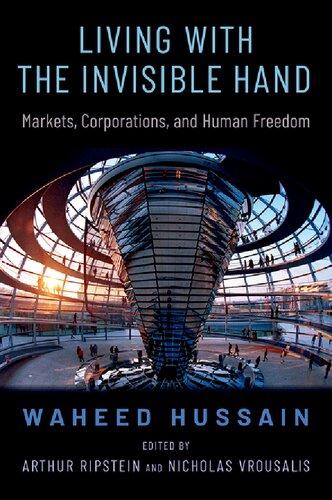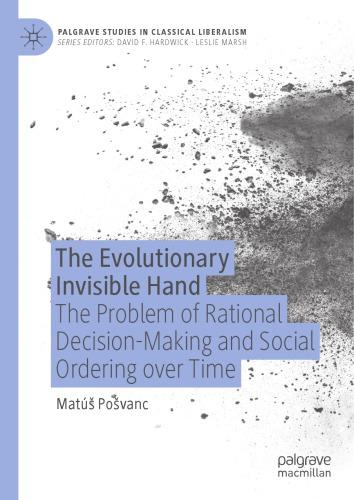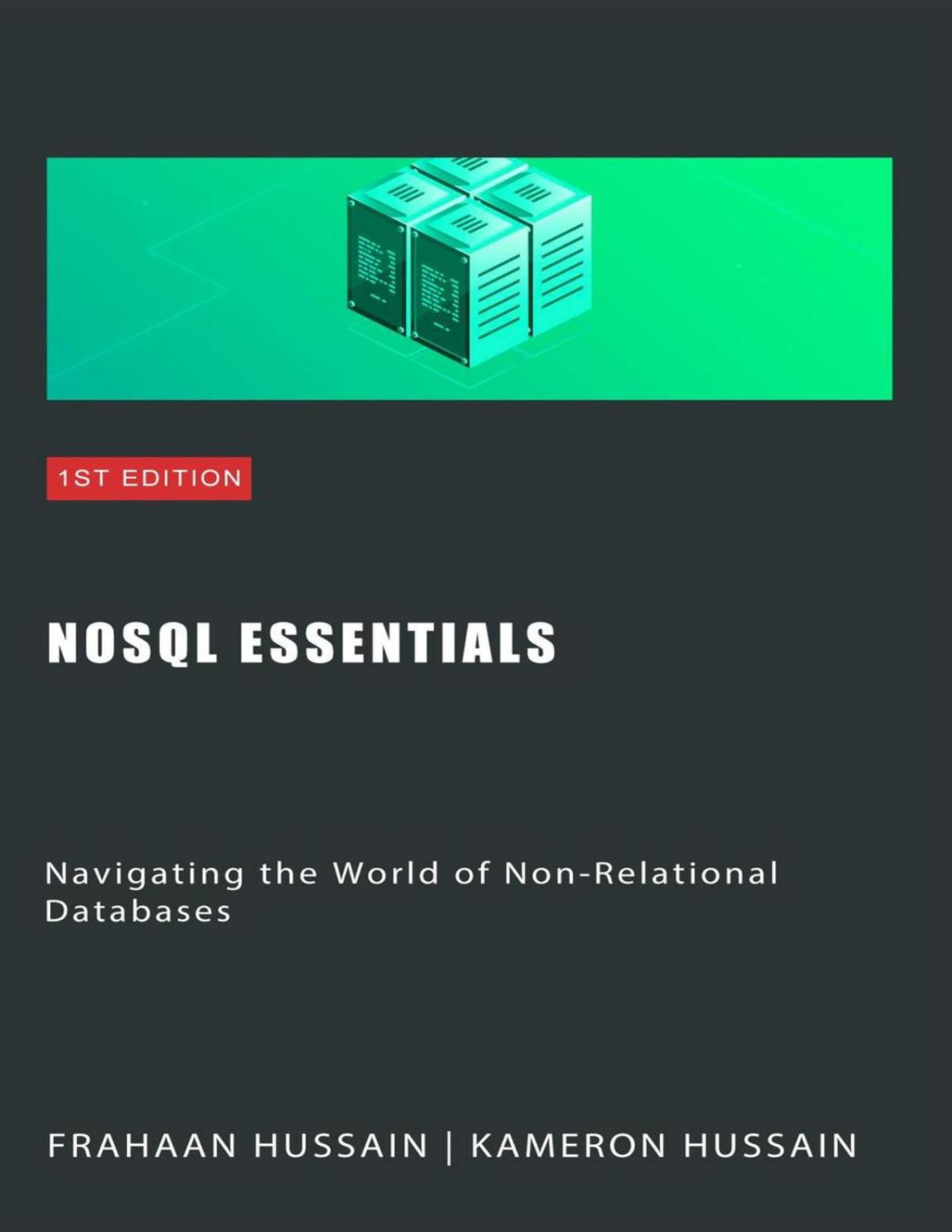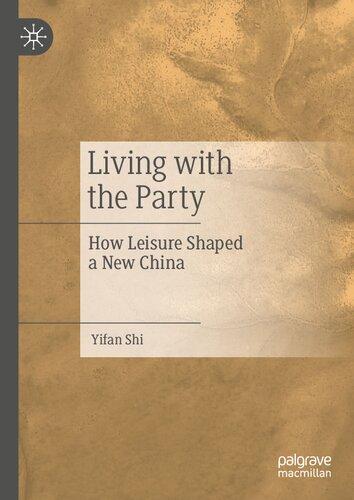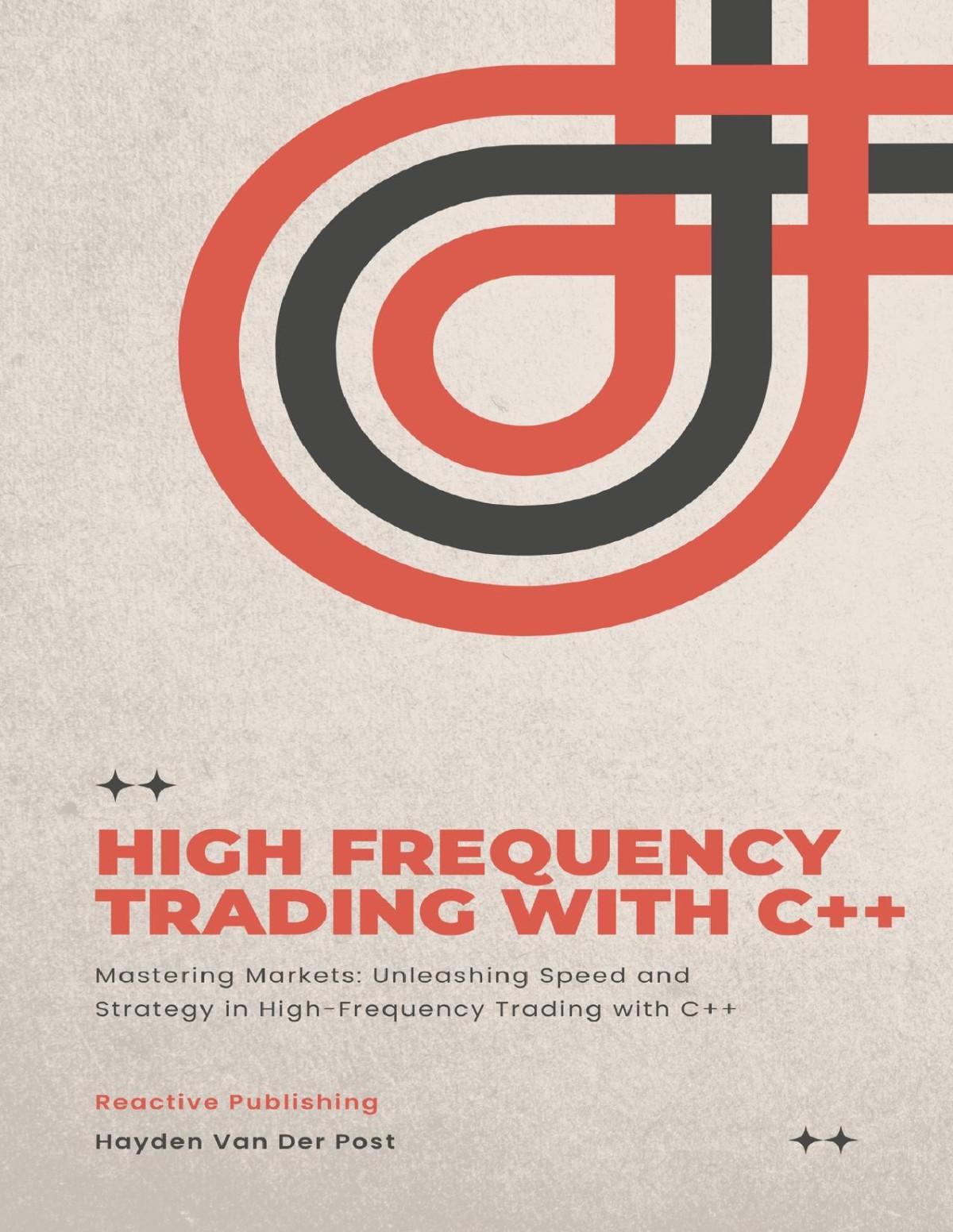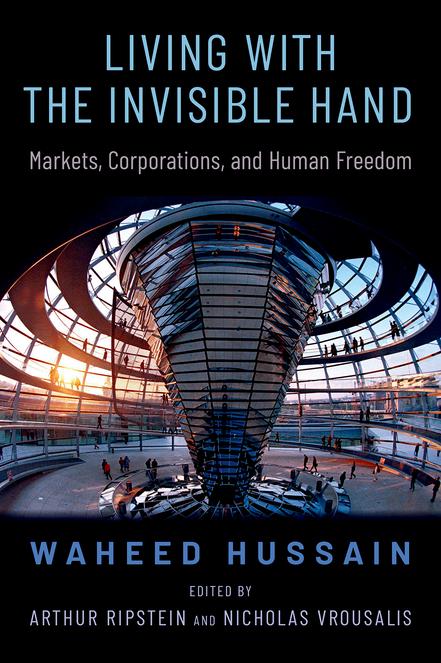Living with the Invisible Hand
Markets, Corporations, and Human Freedom
WAHEED HUSSAIN
Edited by ARTHUR RIPSTEIN AND NICHOLAS VROUSALIS
Oxford University Press is a department of the University of Oxford. It furthers the University’s objective of excellence in research, scholarship, and education by publishing worldwide. Oxford is a registered trade mark of Oxford University Press in the UK and certain other countries.
Published in the United States of America by Oxford University Press 198 Madison Avenue, New York, NY 10016, United States of America.
© Oxford University Press 2023
All rights reserved. No part of this publication may be reproduced, stored in a retrieval system, or transmitted, in any form or by any means, without the prior permission in writing of Oxford University Press, or as expressly permitted by law, by license, or under terms agreed with the appropriate reproduction rights organization. Inquiries concerning reproduction outside the scope of the above should be sent to the Rights Department, Oxford University Press, at the address above.
You must not circulate this work in any other form and you must impose this same condition on any acquirer.
CIP data is on file at the Library of Congress
ISBN 978–0–19–766223–6
DOI: 10.1093/oso/9780197662236.001.0001
Printed by Integrated Books International, United States of America
Foreword
For those of us who knew him, reading Waheed Hussain’s book brings a mixture of sadness and pleasure: sadness at the loss of having his life cut short, and pleasure in hearing again his unique voice and being guided by his distinctive mind.
The main aim of the book, and what I hope will be its important impact, is to open up in a new way the discussion of the relation between freedom and equality. In much discussion, particularly but not exclusively on the right, freedom is understood in terms of the widest range of individual choice, which, it is assumed, the pursuit of equality is bound to restrict. Waheed takes seriously individuals’ reasons for wanting to have a choice about how their lives go. He points out, however, that these values do not determine the form that an economic system should take, since many different economic systems can respect these values. These systems differ in the options they make available to individuals and in the incentives that individuals have for choosing among them. They are thus systems of social control that “steer” individuals to lead their lives in certain ways. They are also dynamic systems that change these options and incentives over time, and differ in the ways that they do this. In a “free market” economy of the kind favored by classical liberals, for example, the options and incentives are determined by supply and demand. They therefore change with changes in technology and in aggregate demand for products and services, disrupting individuals’ lives by loss of employment. (The suggestion is not that this kind of change can be avoided, but only that the cost it imposes on individuals needs to be taken into account in justifying the system of control.)
The problem that Waheed identifies with such dynamic systems of coordination and social control is that they direct individuals’ choices in ways that are independent of the individuals’ own rational faculties. The book is addressed to the question of how such “judgment-bypassing” systems of control can be justified; Waheed’s answer, developed at length, is that they must satisfy the three conditions of reason-sensitivity, transparency, and trustworthiness.
These conditions can be illustrated by the simple example of judgmentbypassing measures that Sunstein and Thaler (2008) call “nudges,” such as encouraging employees to save more for retirement by making payroll deductions for retirement saving the default state that employees must opt out of rather than an alternative they must affirmatively choose. Waheed’s three conditions explain why many find the idea of such nudges objectionably manipulative. Reason-sensitivity requires that having their choices presented in this way is actually in the employee’s own interests. Even if this is so, being nudged may strike employees as manipulation insofar as what is going on is hidden from them. The condition of transparency addresses this by requiring that, insofar as feasible, employees should be put in a position to understand the rationale for these nudges. But, in addition, permitting human resource departments to “nudge” employees may seem objectionable to them because they suspect that HR department will not always be moved to do things that are in fact in the interest of employees rather than serving the conflicting interests of managers and shareholders. This problem of trustworthiness could, for example, be addressed by requiring the way in which options are presented to employees to be approved through a process in which employees are represented.
Applying this analysis to the larger-scale problem of a market economy, Waheed argues in the final chapters of the book (which are somewhat less finished than the rest) that a system in which corporations have the authority to make judgment-bypassing decisions that shape the options of workers and consumers is justified only if these decisions are reached through a process such as the German model of codetermination, in which these groups are represented.
Waheed defends his distinctive view with philosophical depth and subtlety and with much greater familiarity with economics and with the nature of corporations than is common among political philosophers. (This is, perhaps, an effect of his having been “steered” by the job market into his first job at the Wharton School rather than in a traditional philosophy department.)
Waheed’s book offers a novel philosophical perspective on fundamental questions facing us as a society. His argument is clear, instructive, engaging, and even exciting to read. If it receives the wide attention it deserves, his ideas will have important lasting effects even though, regrettably, he is no longer here to defend and develop them.
T. M. Scanlon
Author’s Preface
When I was in high school, I had a lot of menial jobs: cold calling people as a telemarketer, prepping cars at a car dealership, delivering Chinese food, selling clothes in a jeans store, and lots of others. One thing all these jobs had in common was a boss: someone told me what to do, and I almost always did what I was told.
One job I had was at a lunch counter. The assistant manager was a particularly mean-spirited young woman who basically yelled at me and made my life miserable. She tried to fire me a few times, but the manager kept me on—probably because I accepted the abuse. In any event, leaving the lunch counter one day, it dawned on me that almost everyone I knew had a boss. My mother had a boss. My father had a boss. My aunts and uncles had bosses. My neighbors, teachers, and friends had bosses. This seemed incredible to me. How could we live in a society that cared about freedom, and yet almost everyone spent most of their waking hours following orders? The whole thing seemed so unbelievable; I couldn’t understand why people were going along with it.
At the time, I didn’t have any clear ideas about how society worked. But if you had asked me, I think my intuitive idea was something like this: I answered to the assistant manager; the assistant manager answered to the manager; the manager answered to the regional suit; the regional suit to the head office suit; then there were a bunch of suits at the head office. The chain of command basically went up and up until there was a group of people at the top who told everyone what to do.
Fast-forward 10 years. After college, I went to work at an investment bank, with some of the same questions about authority in the back of my mind. The bank had large positions in several public-private ventures, mostly building airports and other public works projects. Part of my job was to listen in on conference calls where CEOs and CFOs would answer questions from other banks, hedge funds, and other institutional investors.
Here I felt I was looking at things from above. The executives on these calls were at the top of the hierarchies that I remembered from high school. They gave the orders to the suits, who gave the orders to the managers, who gave
the orders to ordinary workers. The executives were giving orders, and ultimately they answered to us, the banks, hedge funds, and other institutional investors.
I realized quickly, however, that things were not so simple. The investment bank where I worked was not itself outside of the system: the bank also had shareholders, and our CEO and CFO had to get on conference calls every quarter, answering questions from the bank’s institutional investors. Most of these institutional investors were also like us: they too had institutional investors with voting rights, and their executives too had to get on conference calls every quarter, answering questions from their investors. Even the private equity funds that did not have shareholders had to answer, at some level, to the investors who entrusted them with their money. The idea of a military-style hierarchy with a chain of command leading up to the ultimate decision-makers was too simple. Everybody had to answer to somebody: you could be demanding answers from some people in one meeting, and then be answering to some of the same people in the next. We were all enmeshed in something more sophisticated than a straightforward hierarchy.
Fast-forward another 10 years. After graduate school, I took my first job as an assistant professor at the Wharton Business School. There I taught classes to MBAs and sophisticated business undergraduates, and I came to understand the financial system at a higher level of abstraction. I could see that all of the people in the system I had been a part of were under pressure to make money. Every conference call was about money: shareholders wanted higher share prices, bondholders wanted more secure repayment, private investors wanted higher returns. Many people were making many demands, but really there was one underlying thing that everyone was asking for.
The pressure to make money itself unfolded within a deeper structure. This structure was more fundamental but more difficult to locate: the market. Not the financial market, but the real market, where real people make real things to sell to real people. All of the hierarchies and relations of authority that I knew from before were aimed at making money in the market. And in an important sense, these hierarches and relations of authority developed and persisted precisely because they kept people and resources moving in ways that were profitable.
The question that I started with was: How can we, as a society, be serious about freedom and yet allow a situation to persist in which most people spend most of their waking hours subject to the authority of another person? How can we reconcile a commitment to freedom with a vast system of daily
subjugation? Once you abandon the naïve view of a hierarchy and appreciate how hierarchies can be part of a more impersonal system of social control, the question changes form. The question now is: How can we as a society reconcile our commitment to freedom with a social arrangement in which the market, along with the hierarchies that develop within it, plays a fundamental role in directing our lives? I think that a reconciliation is possible, but we have to think much more carefully about the relationship between markets and freedom.
Acknowledgments
I would like to thank the many colleagues and friends who read parts of the manuscript and gave me valuable feedback: Nicholas Vrousalis, Arthur Ripstein, Joe Heath, Samuel Freeman, Tom Christiano, Christopher McMahon, Patricia Mareno, David Ciepley, John Gardner, Hamish Stewart, Rosa Cao, Nick Barber, Dan Butt, Sophia Reibetanz, and Jappa Pallikkathayil. Tim Scanlon and Joshua Cohen supervised my dissertation at Harvard many years ago, which was my first attempt to work out some of these ideas. They’ve both had a lasting impact on my work.
The Ethics and Economics Network in Europe and the Toronto Area Political Philosophy Workshop were important venues for working through new material. Thanks especially to Sandrine Blanc, Rutger Claassen, Peter Dietsch, Andrew Franklin-Hall, Kerah Gordon-Solmon, Louis Philippe Hodgson, Nien-he Hsieh, Michael Kessler, Hasko von Kriegstein, Rahul Kumar, Martin O’Neill, Julie Rose, Juri Viehoff, Andrew Walton, and Karl Wilderquist. For logistical and financial support, my thanks to the University Center for Human Values at Princeton, the Social Sciences and Humanities Research Council of Canada, the Department of Philosophy at the University of Toronto, and the Department of Legal Studies and Business Ethics at the Wharton School. Thanks also to the many audiences that heard this material at various talks and conferences.
Words can’t do justice to the people who kept my head above water, especially at the end of the writing process. Thanks to my doctors and nurses at the Johns Hopkins Hospital, Sibley Memorial Hospital, and Georgetown University Hospital. Thanks to my wonderful and caring friends: Steve Naplan, Puspa Mohanty, William Bryant, Joanne Liou, Steve Smith, Wendy Jastremski, Anthony Coleman, Paul and Laura Pirocanic, Rajib Chanda, Kathie Legg-Chanda, and Chi Leng. Thanks to my family: Dr. Sajida Hussain, Samira Hussain, Yusra Siddiquee, and my precious Afsi and Zayn. And thanks most of all to Tina Ghosh, the truest friend a person could ever hope for.
January 2021
Introduction
The market plays a central role in the lives of most people in the world today. One reason is that millions of people have money invested in stocks, bonds, houses, and other assets, so most everyone’s financial future depends significantly on what happens in the market. But more important than this is the fact that the market represents one of our most important mechanisms of governance: the market plays a pivotal role in shaping how we live our lives.
Figure 1 presents Yale economist Robert Shiller’s (2006) now famous chart of housing prices over the past 100 years.
What stands out, of course, is the huge run-up of home prices in the early 2000s and the collapse in 2006. The housing bubble was obviously an important financial event, one whose consequences many people are still
Living with the Invisible Hand. Waheed Hussain Edited by Arthur Ripstein and Nicholas Vrousalis, Oxford University Press. © Oxford University Press 2023. DOI: 10.1093/oso/9780197662236.003.0001
feeling today. But the housing bubble was also an important social phenomenon: the bubble redirected huge stockpiles of raw materials from other worthy projects to the project of building new homes; it turned large stretches of uninhabited land into housing developments; it forced residents out of older neighborhoods to make room for new high-rises and condos; and it shifted thousands of workers from other fields into the housing sector. A vast social effort to increase the housing stock in the United States was essentially coordinated and directed by the market.
The market is, in effect, all around us, working all the time to guide us into certain jobs, certain investments, and ultimately certain ways of life. And when we see the market directing enormous resources and energies in ways that are unjustifiable in light of the underlying facts—as was the case in the housing bubble—we naturally question market governance; we may wonder whether we have made the right decision, handing such an important form of control over our lives to the market process.
I.1. Respect for the Value of Freedom
Economists and philosophers have done a great deal to address misgivings about the market, mainly by explaining how the market process tends to generate attractive results (Smith 1976; Hayek 1960; Mises 2012). Markets tend to draw us into a pattern of production activity and consumption activity that is efficient in the economic sense. An efficient pattern is one where there is no other feasible pattern of making things and consuming things that would use scarce social resources in ways that better satisfy people’s desires and needs. This is, undoubtedly, an attractive feature of the market, and we have reason to value a market arrangement for this feature. But even those who agree that this feature is important may find that it alone does not address their misgivings. Among the most important misgivings is that having to do with freedom.
Imagine for the moment that we live in a system of government that concentrates power in the hands of a benevolent dictator D. Suppose that D’s decisions sometimes seem arbitrary and irrational to us, but that he usually directs us to do things that are worthwhile. Although D may direct us in reasonable ways, we would be right to object to an arrangement that allows D to direct our lives unilaterally, without our being involved in the process in a meaningful way. After all, we have our own powers of reasoning and
judgment, and even if a certain pattern of activity is a good one, this pattern should not be imposed on us in a way that bypasses our rational capacities. D’s influence would be all the more objectionable if he were categorically opposed to explaining the reasons behind his decisions to us, the people whose lives are shaped by these decisions.
Market governance has some of the same features as a benevolent dictatorship. The market exercises a powerful and pervasive influence in our lives, leading us into certain patterns of production activity and consumption activity. But the market does not always involve us in the right way in generating these patterns, and it does not explain the reasons behind the patterns that emerge from the process. So even if the market tends to generate attractive patterns of production and consumption, critics are right to question whether market governance is consistent with a proper respect for the value of freedom.
I.2. Corporations and Corporate Executives
Many people feel the tension between market governance and freedom most viscerally in connection with business corporations. Corporate executives exercise a power to determine how people live their lives, and the scope of this power is often breathtaking. For example, along with a small cadre of executives and board members, Darren Woods, the CEO of ExxonMobil, commands the efforts of over 80,000 people employed by the company worldwide and controls assets worth over US$340 billion. These assets include refineries in 21 countries, which together produce more than 3% of the global supply of oil. Woods commands the efforts of 80,000 Exxon employees at work, and the pricing strategies and climate change policies that he adopts significantly shape the context in which everyone must act.
The power of corporations and corporate executives raises fundamental questions about the relationship between corporations and freedom. But in order to understand this relationship, it is important to situate corporations and corporate executives in the context of a broader system of governance. Woods has significant leeway to direct workers and to shape corporate policies as he sees fit, particularly in less competitive markets. But Woods is also subject to market discipline. If he chooses manufacturing strategies and corporate policies that are significantly at odds with market imperatives, ExxonMobil will lose market share. If he sticks to his guns, the company will
face mounting losses and may eventually come to financial ruin. Bankruptcy would disperse the company’s assets to firms more willing to adopt strategies and policies that are profitable. And so, in the long run, the market’s dynamic tendency will be realized, whether through ExxonMobil or some other corporation, whether through Woods or some other corporate executive.
Corporations and corporate executives are powerful actors in society, and I will have more to say about them as such in later chapters. But it is important to see that these actors are also, to a significant degree, the handmaidens of the market, the instruments through which the invisible hand shapes and reshapes our lives.
I.3. The Relationship between Market and Freedom
This book is about the relationship between market governance and respect for the value of freedom. In an era of ever-expanding markets, economists and philosophers are right to draw attention to the signal merits of the market as a mechanism of governance. At the same time, critics are right to argue that market governance is in certain ways inconsistent with a proper respect for freedom. The view that I will develop, which has its roots in the work of Kant ([1797] 1996), Hegel ([1821] 1991), and Marx ([1867] 1967), says that a market arrangement respects the value of freedom in some ways but fails to do so in others, and that there are important ways that we can alter market governance to make it more consistent with this value.
Perhaps the most common view of the relationship between markets and freedom comes out of the classical liberal and libertarian traditions. Theorists such as Friedrich Hayek (1960), Milton Friedman ([1962] 1982), and Robert Nozick (1974) conceive of the importance of freedom in terms of the importance of an individual’s control over her labor and property. Market governance respects the value of freedom, on this view, mainly because it accords each person the authority to decide for herself what she will do with her time and her possessions.
The problem with the property rights view, however, is that it does not appreciate the systemic character of markets. A market arrangement gives each person control over her labor and property, but the options that are open to her in virtue of these forms of control are powerfully shaped by external forces. Imagine, e.g., that a particular individual finds that her control over her labor power opens up certain options for her in the automotive industry.
These options exist, in part, because consumers have certain preferences. If consumer preferences change, the market process may scale back her options in the automotive industry and expand her options elsewhere, perhaps in the healthcare sector. At a certain point, these gradual changes in her option set will move her from one way of life to another. When the market process moves her in this way, it plays an important part in the determination of her conduct. You might say that the market process is like a scientist in a lab, opening and closing doors to lead mice through a maze: it shapes people’s lives without necessarily overruling their authority over their labor and property.
Another view of the relationship between markets and freedom focuses on the power to choose from a wide range of options. We sometimes think of freedom in terms of consumers having the power to choose among a wide range of products, investors having the power to choose among a wide range of investments, and workers having the power to choose among a wide range of job opportunities (see, e.g., Sen 1999).
The choice-centered view has significant merits, but it also suffers from a failure to appreciate the systemic character of markets. A social arrangement that provides individuals with a diverse range of options to choose from may nonetheless embody a form of social control over people’s lives. It may do so if the arrangement manages people’s option sets in such a way as to generate and maintain a certain overall pattern of activity in society. Consider a system of traffic lights in a city. A green light opens up a set of options for a driver; a red light closes them off. If a computer program controls the lights in a city, it can generate and maintain a certain pattern of driving activity—e.g., a traffic jam—by constantly funneling drivers toward a few main streets. Drivers would always have more than one option open to them at intersections, and as drivers each make their choices, they might think that the overall pattern is simply a product of their private choices. But in fact, the pattern is substantially the product of the program that manages the lights.
Much like a system of traffic lights, prices in a market arrangement can change the option sets open to individuals in such a way as to draw everyone into a certain pattern of production activity and consumption activity. Individuals may think that the overall pattern is simply a result of their private choices as consumers, workers, and investors, but the pattern is importantly shaped by the market arrangement.
The key point here is that a market arrangement is a mechanism of social control. When members of a community adhere to the requirements
of the arrangement, they take part in an enterprise that draws individuals into a certain pattern of conduct—i.e., an efficient pattern of production and consumption—and maintains the pattern. Moreover, the arrangement draws individuals into the pattern without regard for the private judgments of individuals about the pattern. An arrangement that bypasses individual judgments to maintain a certain pattern may or may not be consistent with an appropriate respect for freedom. But the property rights view and the choice-centered view both lack the resources to bring the problem into focus.
I.4. The Anti-authoritarian Dimension of Freedom
The correct view focuses instead on what I call the anti-authoritarian ideal This ideal takes as its starting point the fact that a market arrangement is a mechanism of social coordination, an institutional arrangement that is structured so as to draw members of society into certain patterns of activity. Respect for the value of freedom requires that a social coordination mechanism should be consistent with citizens respecting themselves and one another as free persons, each entitled to guide her activities in light of her own practical judgments. When a coordination mechanism is structured so as to maintain a certain pattern without an appropriate concern for the private judgments of individuals about the pattern, it is authoritarian and violates the requirements of the ideal.
An important feature of the anti-authoritarian dimension of freedom is that it has a complex structure that allows for social coordination mechanisms to rely, in certain cases, on judgment-bypassing forms of social control. These forms of control are consistent with the ideal when citizens face limitations that would prevent them from drawing themselves into a rational pattern of activity on their own. Given the limitations in citizens’ rational capacities, a social arrangement is consistent with the anti-authoritarian ideal if (a) the arrangement draws citizens into the most rational or choice-worthy pattern of activity; (b) the arrangement enables citizens to judge for themselves the merits of the pattern; and (c) the arrangement gives citizens a rational basis for trusting that the arrangement is drawing them into the most rational pattern of activity.
Let’s assume that coordinating the overall pattern of production and consumption in a large political community is an extremely complex and timesensitive enterprise, and that citizens could not realistically hope to organize
and reorganize themselves in rational patterns on their own. A market arrangement is consistent with the anti-authoritarian ideal mainly insofar as it draws citizens into attractive patterns of production and consumption activity in this context. Suppose that the market leads someone to the healthcare sector by scaling back her options in car manufacturing. Suppose that it does so in response to a change in consumer preferences. If the underlying needs in society have changed, then there may be greater reason to adopt a pattern in which the individual works in healthcare rather than in car manufacturing, and so the market process guides society toward the most attractive pattern, all things considered.
On the other hand, one of the central weaknesses of market governance is a lack of transparency: the market does not reveal to people why they should perform the tasks that it directs them to perform. If the market guides someone into healthcare by scaling back her options in car manufacturing, it does nothing to explain to her why it is moving her in this way. Has there been a change in consumer preferences? Have new technologies changed relative efficiency? Are unfair trade practices behind the shift? The arrangement does not give the individual any account of the underlying reasons that justify this new pattern of activity, so it does not put her in a position to participate in the pattern on the basis of her own practical judgments.
I.5. Intermediated Capitalism
Reason-sensitivity and transparency are central to the anti-authoritarian ideal, and these ideas point to a program for improving market governance. Many countries in Europe have economic institutions that rely significantly on democratic forms of intermediation to help coordinate their economy. These institutional arrangements belong to the broader family of marketbased systems, but they structure and temper market governance in ways that are different from an American-style arrangement.
Take Germany, for example, the economic powerhouse of Europe. Germany has a market economy, but its institutions are different from those in the United States. Under the German “codetermination” system, industrywide unions have a seat on the supervisory boards of large corporations, such as Daimler and Siemens. Moreover, these industry-wide unions participate in various industry-level rule-making forums, alongside encompassing associations that represent shareholders. The various elements of the
codetermination system allow the representatives of labor to work alongside the representatives of capital in understanding and shaping patterns of production (and consumption) in society.
The anti-authoritarian ideal says that the European model of market governance answers better to the value of freedom than the American model. Democratic intermediation improves the reason-sensitivity of the market process by making it more sensitive to the reasons that workers have for participating in certain forms of production. At the same time, collaborative reasoning, deliberation, and monitoring help to disperse information, making clearer to workers how various changes track or fail to track the relevant underlying considerations. These measures improve transparency. The codetermination system is a model for respecting freedom in market societies, and I will argue that we should develop the model further to address the facts of globalization.
I.6. Displacing the Neoliberal Outlook
A deeper motivation for this book has to do with our current thinking about economic life. Our political culture today tends to view economic life through a lens shaped by a family of Lockean ideas about private property and Utilitarian ideas about social welfare. These ideas are not always clearly articulated or fully coherent, but they serve as the background for various arguments in favor of neoliberal policies that treat finance capitalism as “perhaps the most beneficial economic institution known to human kind” (Rajan and Zingales 2003).
Although there are good arguments that you could make for codetermination from within the broader outlook that informs neoliberalism, these arguments could never form the basis for a stable political consensus in support of codetermination on their own. This is because the deep moral appeal of codetermination draws on an outlook that is fundamentally different from both Lockeanism and Utilitarianism.
The deep moral appeal of codetermination flows from a broadly Kantian perspective on economic life.1 On my view, economic actors are members of
1 Kant himself does not view economic life this way: he conceives of the market mainly as a system of private property, not an institution that creates the conditions for our production activities and consumption activities to form a dynamical system. Later writers developed Kant’s ideas in this direction; see Hegel ([1821] 1991), Marx ([1867] 1967), Habermas (1996).
a political community. Shared social institutions define a framework for how members of the community should think and act toward one another. And this shared framework must be consistent with citizens respecting themselves and one another as free persons, each entitled to guide her activities in light of her own practical judgments. According to the Kantian perspective, the market is one of these shared institutions, so its rules must also be consistent with mutual respect as free persons. The Kantian perspective rejects the idea that we can treat each other as mere tools or machines in economic life, so long as our political institutions are properly structured to embody mutual respect in the democratic process. In this way, the Kantian perspective represents a fundamentally different way of thinking about economic life, a way that rejects both the view of economic actors as disconnected individuals in a state of nature (Lockeanism) and the view of economic actors as mere preference orderings that are inputs in a giant social welfare function (Utilitarianism).
The Kantian perspective helps us to understand the intuitive appeal of codetermination, and in doing so it serves an important political purpose. In order to formulate the basis for a stable, long-term political consensus in support of codetermination, something that we find in the Germanspeaking countries in Europe, we need to articulate this underlying perspective as clearly as possible. We need to formulate a deeper framework for thinking about economic life that can displace the family of moral ideas that underpins finance capitalism as we know it. This book contributes to the wider project by working out the implications of the idea that even in economic life we are citizens in a political community who must respect one another as free persons.
I.7. The Plan for the Book
Chapters 1 and 2 set out a framework for thinking about normative issues in economic life. The “institutional perspective” stresses the importance of social institutions and public values in thinking about these questions, and it provides us with an important basis for rethinking certain misleading contemporary approaches to the public-private distinction.
Chapters 3 to 6 are the heart of the book and set out a new conception of the relationship between markets and respect for the value of freedom. The first idea is that an advanced market economy is a coordination mechanism.
When members of a political community adhere to the requirements of the arrangement, their production activities and consumption activities form a dynamical system, one that constantly adjusts and readjusts to changing circumstances in order to maintain a pattern that is economically efficient (i.e., Pareto optimal). The process of adjustment works through prices, which constantly change the option sets open to individuals so as to draw them into efficient patterns. But these changing option sets draw individuals into patterns in a way that bypasses their private judgments about the merits of these patterns.
Chapters 4 and 5 present a theoretical account of a moral defect that coordination mechanisms may exhibit when they maintain patterns through a judgment-bypassing process. This defect is authoritarianism. Social coordination mechanisms may be authoritarian when they rely on a judgmentbypassing process to maintain a certain pattern in social life. Drawing a parallel between political authority structures and market coordination, these chapters explore the restricted circumstances in which a judgmentbypassing coordination mechanism may be justified.
Chapter 6 assesses an advanced market economy in terms of the antiauthoritarian ideal. I argue that an advanced market economy does not satisfy the requirements of reason sensitivity, transparency, and trustworthiness as a stand-alone mechanism. Moreover, even a liberal market democracy that embeds an advanced market economy in a more complex regulatory process and legislative process fails to satisfy the three requirements.
Chapter 7 elaborates the theory laid out in chapters 3 to 6 to address normative questions about the business corporation. Many theorists think of business corporations as stand-alone authority structures on the model of the state (e.g., McMahon 1994, 2013; Ciepley 2013; Anderson 2017). According to the “dynamical view” of the business corporation, corporations come together and break apart as part of the market coordination process; they are properly understood as vehicles that help the price system to maintain an overall pattern of production and consumption in society that is economically efficient. Moral subordination in a market society is, significantly, subordination to this impersonal process. And when we think about the right way to structure an advanced market economy, we should think about the internal authority structure of business corporations and various features of corporate law as parts of a wider coordination mechanism that must satisfy the three requirements.
Chapter 8 lays out a model for how an advanced market economy could be structured so as to satisfy the anti-authoritarian ideal. Intermediated capitalism is a market arrangement that has all the features of an advanced market economy but also incorporates deliberative rule-making mechanisms at the level of firms and industries to improve rationality and transparency and to give citizens a greater basis for trusting in the market process. The codetermination system in Germany has certain features—such as representative rule-making at the level of the corporation—that answer to the model, and the chapter appeals to the German example to illustrate the idea.
Over the course of these eight chapters, some readers may find themselves wondering at times what exactly a market economy is—or at least what exactly I think it is. For the most part, contemporary political philosophy operates with a somewhat vague conception of a market economy, but a more precise view is necessary to address certain issues. Rather than clutter the main argument with a pedantic definitional chapter, I have included an appendix that lays out the conception of a market economy that informs the argument of this book.
A key element in the conception is mutual disinterest. A market economy, on my view, is an arrangement that requires (not simply permits) agents to act in a mutually disinterested fashion. This requirement is formalized in US antitrust law and European competition law, which both legally require market actors to act in a mutually disinterested fashion—sometimes on pain of criminal sanctions. A market arrangement would be less likely to generate efficient outcomes if economic actors systematically violated the requirement of mutual disinterest, so insofar as the justifying rationale for a market economy is economic efficiency, we should understand mutual disinterest as a requirement of the institution (not just a permission).2 If at some point in reading the main argument, you find yourself wondering what exactly a market economy is, turn to the appendix and consider one attempt to be rigorous about the nature of this fundamental institution in modern social life.3
2 A market arrangement would be less likely to generate efficient outcomes if economic actors systematically violated the requirement of mutual disinterest. One type of problem has to do with information: if A knows best what is in A’s interest and B knows best what is in B’s interest, then a situation in which A and B each spend some of their time pursuing the other’s interests would likely generate an outcome that is Pareto inferior to the one that results when they are each purely self-interested (see Sen 1984b).
3 [Chapter 8 discusses eight conditions for an advanced market economy. Hussain’s working definition is: “a basic bargaining system whose rules are structured to create a society-wide mechanism of social coordination, one that shapes social patterns of production and consumption.”—Eds.]
